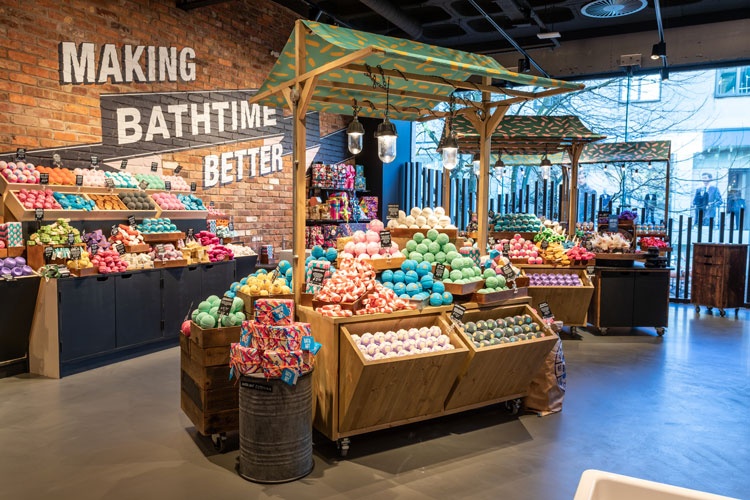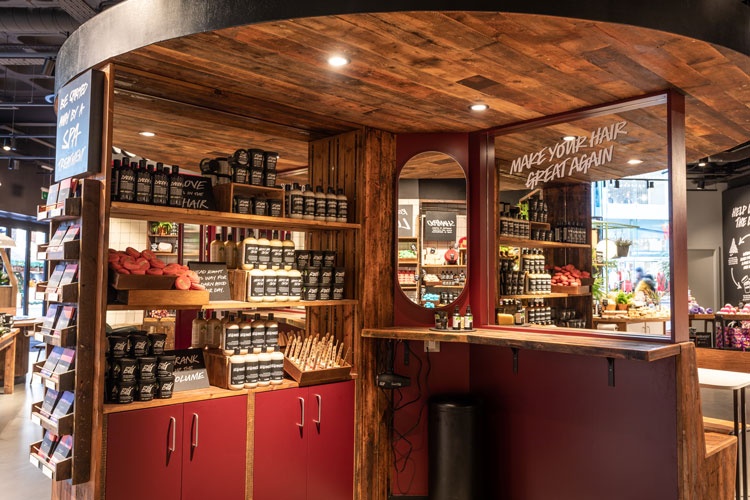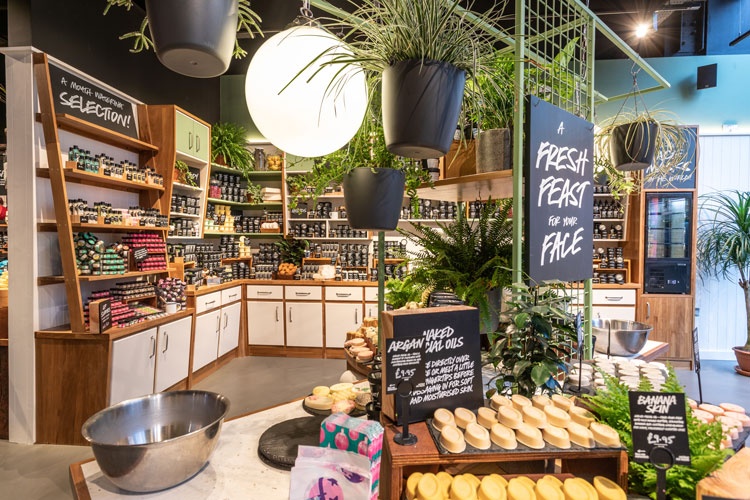From VR experiences to going cashless: could design save the high street?
Amid a tough retail climate and increasing competition from online stores, we look at how bricks-and-mortar shops are finding new ways to entice customers.

Britain’s high street has been struggling for some time now. A day rarely passes without headlines about shutters going down on a store, loss-making chains fighting to stay afloat and other gloomy forecasts.
In 2018, Toys R Us went into administration, House of Fraser announced store closures and the year rounded off with HMV revealing it is in trouble.
It is a tough climate – as well as pressures from rising rents and business rates, bricks-and-mortar retailers are facing more and more competition from online shopping, with people increasingly spending money online.
In November last year it was found that over a fifth of all retail sales were carried out online, according to the Office for National Statistics, which is an all-time high. Meanwhile, over 11% of retail premises stood vacant in the latter half of 2017, according to research by the Local Data Company cited in a government report.
With a world of choice, reviews, suggestions and delivery at the click of a button, the ease of online shopping is a draw for many, far outweighing the idea of travelling to a store, searching for items and queuing to pay.
To compete, many stores are turning to design-based solutions to attract customers, from in-store experiences to smart technology.
In-store experiences
Immersive experiences and events are a growing trend; from virtual reality rides and sports zones, to live music performances and beauty treatments, stores are designing new, enticing reasons for customers to come inside.

The Nike store in SoHo, New York, for example, has a mini basketball court, an enclosed football goal and a treadmill set up in front of screens, where people can run while watching footage of the outside world, and can try out trainers and other products in a real-world environment.
While some retailers are weaving experiences into the physical store design, others are hosting pop-up events, often enlisting the help of design studios.
YourStudio has worked on a number of immersive projects such as a water slide pop-up known as Splash, installed at Topshop’s flagship London store on Oxford Street in 2017, which included a virtual reality (VR) experience.
“We wanted the products to be a by-product of the experience in store and to create something magical for customers that they didn’t expect,” says Tom Edington, associate director of environments at YourStudio.
 Photo: © Topshop, courtesy of YourStudio.
Photo: © Topshop, courtesy of YourStudio.
The studio worked alongside Fat Unicorn, which created VR content, to design an immersive experience where people could sit on a physical water slide installation wearing a VR headset and take a “magical” journey through Oxford Street.
To draw customers in, YourStudio created window displays projecting the sounds of seagulls on to the street and pumped the scent of sun tan lotion through the entrance, in a bid to attract passers-by and “evoke an emotion”. Physical water slides were installed throughout the store.
“Memories and moments”
“Everyone wants that break from their norm,” says Edington. “We had people queuing up through the store and outside. [The VR slide] had over 400 users per day.”
He says the experience had an impact on the store’s performance and “sales massively peaked during the time” it was on.

Other examples of the studio’s work include a sensory “beehive” pop-up for jewellery store Pandora in Australia, where customers became the “bees”.
“Scented gold flowers around the hive drew customers in,” Edington says. “Inside they would hear the buzz of the hive. They would go to sniff a flower and then see the product, a little bee bracelet charm. Upon leaving, customers would get a gold leaf ice cream.”
He believes creating “memories and moments” will become key to retailers’ success.
“Customers are very savvy now – you must reward them with something,” he says. “Doing reams of display is not rewarding, you have to do things to make them want to go to store.
“I think we will see more interesting things, instead of retailers just shoving a coffee shop in-store.”
Seamless shopping
Retailers are increasingly recognising the need to design seamless experiences which make shopping in store as easy and convenient as online shopping. Some have been experimenting with going cashless through the use of new technology.
Having already dominated the online shopping world, Amazon has designed a series of cashless and checkout-less physical food stores, called Amazon Go. Launched in multiple destinations across the US, shoppers can come to the store, pick up what they want and walk out without physically paying. It works with an app which uses sensors and algorithms to track what shoppers pick up, letting them pay through the app later.
A number of supermarkets have also been testing out till-less stores, with Tesco among those giving the concept a go in select branches and Co-Op reported to be trialling the technology.

An early example of the effect of seamless tech improving shopping experiences is Argos’ store redesign. While now the customer experience change seems simple, Argos’ transition a few years’ back from physical catalogues to digital screens for buying products in-store may have played an important role in keeping the retailer relevant on today’s high street. Dalziel & Pow is the design studio behind the concept.
Ed Nelson, design director at the studio, says: “Argos didn’t have a great perception on the high street, the methodology with their catalogues in that day and age was a bit antiquated.
“It was about a strategic shift in the business to future proof their position going forward, bringing the seamless customer journey that customers were experiencing at home, in store.”

The move also allowed them to remove tills from most Argos stores, freeing up staff to be on the shop floor to help customers, which Nelson says also improved staff satisfaction levels.
Buy a car and a new outfit at the same store
Following on from Argos, the studio took the “omnichannel” concept, which aims to create a seamless experience by bringing a digital platform into a bricks-and-mortar space, and applied it to Rockar car-buying service, bringing it to high streets. Nelson says this was a “natural evolution” of the Argos model.
He explains that Rockar founder Simon Dixon was disillusioned with the way car showrooms worked. “Generally, they were located out of town on drafty retail estates where no-one went unless they were looking to buy a car,” he says. “There are overbearing sales people and hidden costs.”

“We took [Dixon’s] thinking and created the Rockar model, which is shopping mall-located digitally-enhanced boutiques. They have a series of touch screens where you can value your car in 60 seconds and buy a new car in five minutes. It has radically transformed the way you buy a car.”
Dalziel and Pow was involved in creating Rockar’s digital content, tone of voice, brand identity, graphics and developing the “customer journey”, while the software was coded by an external developer.
Several car brands have adopted the Rockar model, including Hyundai, Mitsubishi, Ford and Jaguar Land Rover.
A Rockar Ford showroom has also opened at a Next store in Manchester’s Arndale shopping centre, giving customers who come in to buy clothes the chance to look for a new car at the same time. Dalziel and Pow was also involved in the interior design of the showroom.
Nelson says the stores have attracted a new customer-base to car buying, partly due to the larger footfall in shopping centres.
“A lot of customers weren’t in the mindset of buying vehicles until they saw these stores,” Nelson adds.

Using the examples of Hyundai’s Rockar store, he says data showed that the demographics of those shopping with them changed, from the average shopper being a man in his fifties at a traditional Hyundai store, to a woman in her thirties at a Rockar store.
In future, Nelson believes digital applications in stores will become “more seamless”, with people using tools they already have such as smartphones to complement the in-store shopping experience.
“It is important not to be a less convenient version of the website,” Nelson says. “Humans can get anything they want when they want but they still want magic.” Quoting Boxpark founder Roger Wade, he adds that the lack of interaction consumers have when shopping online, “makes buying online like watching fireworks on TV.”

Personalised experiences
Another way retailers are enticing customers into stores is by creating a more personalised shopping experience. While product reviews and item suggestions help people decide what to buy online, smart changing rooms and mirrors are among the gadgets helping people make choices in-store.
In Berlin, design studio Seymourpowell has designed a smart mirror for a Superdry store, which lets customers “virtually try on” clothes. Products are put on a three-dimensional (3D) avatar in the mirror, which is controlled through a gesture-based interface reflecting the movements of the person stood in front of it.

The piece was designed in response to a brief for a “‘showstopper’ customer engagement piece”, says Craig Bunyan, senior designer at Seymourpowell.
“Projects like the Superdry smart mirror give customers novel experiences that they can’t have at home, which is going to be the new expected norm among the post-internet-revolution high street shopper,” he adds.
As well as providing an “engaging experience” for the shopper, he adds that the mirror could also capture “customer insights” through a system which “recorded votes on each garment design”, a “valuable” asset for Superdry’s design and marketing teams.
The studio has created similar mirror-based experiences for clients including Lego and Fenwick, which Bunyan says has driven “an increase in footfall, dwell time and social media sharing”.

“Visiting the shops is no longer about servicing purchasing-need,” Bunyan says. “Online shopping is already fundamentally better at this and improvements in artificial intelligence (AI) and increasing integration with [smart home] devices make it better every day. The business case for physical retail spaces is changing from a ‘sales-per-square-metre’ to an ‘experience-per-square-metre’ model.”
Ethical design
A retailer’s values and ethics may also influence its chances of survival and success on the high street.
One store known for its ethical stance is handmade cosmetics brand, Lush, which offers lots of “naked” products without packaging and campaigns on issues such as animal testing.

Jo Evans, Lush’s head of new concept/store design for research and development (R&D), believes Lush’s ethical actions and design attracts people into stores.
“I do think our customer base chooses us because of these things as well as the products,” she says. “We have quite a cult following. Now it is cool to be plastic-free, but we were ahead of the game in that respect. We are always thinking of ways to take it further.”
The company offers many of its products such as bath bombs, soaps and solid shower gels without any wrapping. Where packaging is used, such as in little black Lush pots made of recyclable polypropylene plastic, customers are invited to bring back the empties.
“We recycle them, chip the material down and make it back into pots,” Evans says. “If someone brings more than five pots, they get a free face mask.”

Lush is experimenting with completely plastic packaging-free stores and has recently opened a bath bomb shop in Japan with no packaging at all. Using a mobile phone app called Lush Labs, customers can scan products in store with a smartphone camera using the Lush Lens feature, which uses AI to display information and ingredients.
The company is keen to take the concept further, but Evans says that Lush must ensure it is not excluding people without smartphones.
Store interiors are designed with sustainable materials as far as possible, she adds, for example by sourcing timber from ethical suppliers which also plant trees.
“We give ourselves a traffic light system,” she says. “Material researchers give us a list of materials that are great to use, okay to use, and those we definitely should not use.
The company also tries to consider its own waste management, Evans adds, and as much as possible strives to create a “closed loop” system where its waste is collected, recycled and remade or repurposed into something new and useful.

“We trace the supply chain of our materials, and if we can incorporate our own waste streams within that in a closed loop, we will strive to do that. What we do is very hard work so most people don’t bother.”
Do more in-store
Lush’s in-store experiences are also worth noting – the company lets customers try many of its products, with sinks for testing items and staff offering demonstrations and providing information and advice.
“It is hands-on, you can pick [a product] up, smell it, touch it, play with it and have a demo,” Evans says. “There is no restriction of what you can do in store.”

Some branches offer skincare consultations and facials, while London’s Oxford Street store even has a hair washing station.
Evans believes Lush’s ability to “innovate” has helped the store do well on the high street where some others have not.
In the current retail climate, it is clear that something needs to change if the high street is to survive, with design-based solutions such as these offering a glimpse of what the future could bring.
It is likely we will continue to see more experiences and smart tech incorporated in-store, both closing the gap between the worlds of online and physical retail and offering something that online shopping cannot.
-
Post a comment




